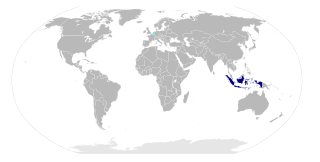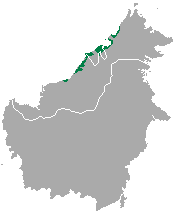
Indonesian is the official and national language of Indonesia. It is a standardized variety of Malay, an Austronesian language that has been used as a lingua franca in the multilingual Indonesian archipelago for centuries. Indonesia is the fourth most populous nation in the world, with over 279 million inhabitants of which the majority speak Indonesian, which makes it one of the most widely spoken languages in the world. Indonesian vocabulary has been influenced by various regional languages and foreign languages. Many borrowed words have been adapted to fit the phonetic and grammatical rules of Indonesian.

Malay is an Austronesian language that is an official language of Brunei, Indonesia, Malaysia, and Singapore, and that is also spoken in East Timor and parts of Thailand. Altogether, it is spoken by 290 million people across Maritime Southeast Asia.

Jawi is a writing system used for writing several languages of Southeast Asia, such as Acehnese, Banjarese, Kerinci, Maguindanaon, Malay, Mëranaw, Minangkabau, Tausūg, and Ternate. Jawi is based on the Arabic script, consisting of all of the original 31 Arabic letters, and six additional letters constructed to fit the phonemes native to Malay, and an additional phoneme used in foreign loanwords, but not found in Classical Arabic, which are ca, nga, pa, ga, va, and nya.

Nusantara is the Indonesian name of Maritime Southeast Asia. It is an Old Javanese term that literally means "outer islands". In Indonesia, it is generally taken to mean the Indonesian Archipelago. Outside of Indonesia, the term has been adopted to refer the Malay Archipelago.
In addition to its classical and modern literary form, Malay had various regional dialects established after the rise of the Srivijaya empire in Sumatra, Indonesia. Also, Malay spread through interethnic contact and trade across the south East Asia Archipelago as far as the Philippines. That contact resulted in a lingua franca that was called Bazaar Malay or low Malay and in Malay Melayu Pasar. It is generally believed that Bazaar Malay was a pidgin, influenced by contact among Malay, Hokkien, Portuguese, and Dutch traders.

Malaysian Malay, also known as Standard Malay, Bahasa Malaysia, or simply Malay, is a standardized form of the Malay language used in Malaysia and also used in Brunei and Singapore. Malaysian Malay is standardized from the Johore-Riau dialect of Malay. It is spoken by much of the Malaysian population, although most learn a vernacular form of Malay or another native language first. Malay is a compulsory subject in primary and secondary schools.

The Kedayan are an ethnic group residing in Brunei, Federal Territory of Labuan, southwest of Sabah, and north of Sarawak on the island of Borneo. According to the Language and Literature Bureau of Brunei, the Kedayan language is spoken by about 30,000 people in Brunei, and it has been claimed that there are a further 46,500 speakers in Sabah and 37,000 in Sarawak. In Sabah, the Kedayan mainly live in the southern districts of Sipitang and Beaufort, where they are counted as a part of the local Malay populace. Whilst in Sarawak, the Kedayans mostly reside in the towns of Lawas, Limbang and Miri.
Keling or Kling is an exonym to denote a Tamilian or someone deemed to have converted from Hinduism to Islam, since the mid-20th century it has been considered derogatory and an ethnic slur. The term is used in parts of Southeast Asia, particularly the Malay Archipelago where there are a significant Tamil diaspora — specifically Malaysia, Indonesia, Singapore and Brunei — but cognates exist in neighbouring countries as well.
Bahasa Rojak or Rojak language is a Malaysian pidgin formed by code-switching among two or more of the many languages of Malaysia. Bahasa means "language", while rojak means "mixture" in Malay, and is a local food of the same name.

Malay was first used in the first millennia known as Old Malay, a part of the Austronesian language family. Over a period of two millennia, Malay has undergone various stages of development that derived from different layers of foreign influences through international trade, religious expansion, colonisation and developments of new socio-political trends. The oldest form of Malay is descended from the Proto-Malayo-Polynesian language spoken by the earliest Austronesian settlers in Southeast Asia. This form would later evolve into Old Malay when Indian cultures and religions began penetrating the region, most probably using the Kawi and Rencong scripts, some linguistic researchers say. Old Malay contained some terms that exist today, but are unintelligible to modern speakers, while the modern language is already largely recognisable in written Classical Malay of 1303 CE.

Greater Indonesia was an irredentist political concept that sought to bring the so-called Malay race together, by uniting the territories of the Dutch East Indies with British Malaya and British Borneo. It was espoused by students and graduates of Sultan Idris Training College for Malay Teachers in the late 1920s, and individuals from Sumatra and Java, including Mohammad Natsir and Sukarno, on September 28, 1950. Indonesia Raya was adopted as the name of what later became the Indonesian national anthem in 1924.
The modern Malay or Indonesian alphabet consists of the 26 letters of the ISO basic Latin alphabet. It is the more common of the two alphabets used today to write the Malay language, the other being Jawi. The Latin Malay alphabet is the official Malay script in Indonesia, Malaysia and Singapore, while it is co-official with Jawi in Brunei.

There are a number of languages spoken in Brunei. The official language of the state of Brunei is Standard Malay, the same Malaccan dialect that is the basis for the standards in Malaysia and Indonesia. This came into force on 29 September 1959, with the signing of Brunei 1959 Constitution.

Malay Indonesians are ethnic Malays living throughout Indonesia. They are one of the indigenous peoples of the country. Indonesian, the national language of Indonesia, is a standardized form of Riau Malay. There were numerous kingdoms associated with the Indonesian Malays along with other ethnicities in what is now Indonesia, mainly on the islands of Borneo and Sumatra. These included Srivijaya, the Melayu Kingdom, Dharmasraya, the Sultanate of Deli, the Sultanate of Siak Sri Indrapura, the Riau-Lingga Sultanate, the Sultanate of Bulungan, Pontianak Sultanate, and the Sultanate of Sambas. The 2010 census states that there are 8 million Malays in Indonesia; this number comes from the classification of Malays in East Sumatra and the coast of Kalimantan which is recognized by the Indonesian government. This classification is different from the Malaysia and Singapore census which includes all ethnic Muslims from the Indonesian archipelago as Malays.

The Brunei Malay language, also called Bruneian Malay language, is the most widely spoken language in Brunei and a lingua franca in some parts of Sarawak and Sabah, such as Labuan, Limbang, Lawas, Sipitang and Papar. Though Standard Malay is promoted as the official national language of Brunei, Brunei Malay is socially dominant and it is currently replacing the minority languages of Brunei, including the Dusun and Tutong languages, existing in a diglossic speech, wherein Brunei Malay is commonly used for daily communication, coexisting with the aforementioned regional languages and Malay creoles, and standard Malay used in formal speech; code switching between standard Malay and Brunei Malay is spoken in informal speech as a lingua franca between Malay creoles and regional languages. It is quite similar to Standard Malay to the point of being almost mutually intelligible with it, being about 84% cognate with standard Malay. Standard Malay is usually spoken with Brunei pronunciation.
This article explains the phonology of Malay and Indonesian based on the pronunciation of Standard Malay, which is the official language of Brunei, Singapore and Malaysia, and Indonesian, which is the official language of Indonesia and a working language in Timor Leste. There are two main standards for Malay pronunciation, the Johor-Riau standard, used in Brunei and Malaysia, and the Baku, used in Indonesia and Singapore.
The Indonesian-Malaysian orthography reform of 1972 was a joint effort between Indonesia and Malaysia to harmonize the spelling system used in their national languages, which are both forms of the Malay language. For the most part, the changes made in the reform are still used today. This system uses the Latin alphabet and in Malaysia is called Joint Rumi Spelling, and in Indonesia Perfect Spelling or Enhanced Spelling. It replaced the Za'aba Spelling that was previously standard in Malaysia, Singapore and Brunei, and the Republican Spelling System in Indonesia.

Riau Malays is a Malays sub-ethnic originating from the Riau and Riau Islands province. The main areas of the Riau Malays are on the east coast of Riau, mostly in Bengkalis, Indragiri Hulu, Kampar, and the Pekanbaru City area which was the base of the Malay Kingdom in the past. The Riau Malays are famous for Riau Malay Literature which is well applied in rhymes, syair, gurindam, hikayat, karmina, seloka, traditional poems, local proverbs, mantras, and romance stories, as well as other forms of expression which they use to express their feelings.
The Congress Spelling System is a spelling reform of Malay Rumi Script introduced during the third Malay Congress held in Johor Bahru and Singapore in 1956. The main characteristics of the system are the use of symbols in the Americanist phonetic notation, going by the dictum of one symbol for one phoneme, and the new proposition in the writing of diphthongs.











